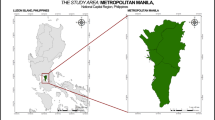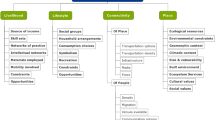Abstract
The purpose of this study is to understand changes in green infrastructure (GI) in the Seoul metropolitan area, South Korea, focusing on the critical GI components of hubs and links. We applied a morphological analysis tool, morphological spatial pattern analysis (MSPA), to explore GI in the Seoul metropolitan area. For input data to run MSPA, we used 30-m pixel-sized land cover data of 2000 and 2009 provided by the Ministry of Environment of Korea. Land cover data are used as foundational information for GI network mapping. Using MSPA, we examined morphological changes in hubs and links from 2000 to 2009 in the metropolitan area as well as in 32 municipalities in Gyeonggi-do, a major part of the metropolitan area. Our analysis showed that the area of hubs in the Seoul metropolis has decreased, while the number of links has dramatically increased, over this 10-year period. This implies that hubs have largely been fragmented into smaller ones with a rapid increase in links in a way that does not conserve and enhance GI. We also compared analysis of network area changes in the Seoul metropolitan area with the environmental conservation value assessment map (ECVAM) currently in use by the government to assess conservation value, and found that the network areas of 2009 mapped by MSPA corresponded to a 87.8 % level to the Grade I areas of the ECVAM, with variation by municipality. From these analyses, we conclude that MSPA is helpful in establishing conservation planning strategies optimized for local and regional contexts. The MSPA also provides a useful tool to complement the ECVAM for improving GI functions.










Similar content being viewed by others
Notes
In this study, the terms hub and core are used interchangeably with link and bridge, because the MSPA software uses the latter terminology.
References
Bae C (2013) Urban Densification: The Greenbelt in Seoul (from the website http://blogs.ubc.ca/cindybae/2013/04/08/the-greenbelt-in-seoul. Accessed 29 Sept 2014
Benedict M, McMahon E (2002) GI: smart conservation for the 21st Century. Renew Resour J 20(3):12–17
Carr, MH, Hoctor TD, Goodison C, Zwick PD, Green J, Hernandez P (2002) Final Report: Southeastern Ecological Framework (from the website http://www.geoplan.ufl.edu/epa/index.html Accessed 15 Jan 2014
Conn C (2009) Green Infrastructure and Greenprint. Maryland Natural Resource
European Environmental Agency (2011) Green infrastructure and territorial cohesion. EEA Technical, Report 18
Forman R (1995) Land mosaics: the ecology of landscapes and regions. Cambridge University Press, Cambridge
Hoctor TS, Carr HM, Zwick PD (2000) Identifying a linked reserve system using a regional landscape approach: the Florida ecological network. Conserv Biol 144:984–1000
Jeon S, Song W, Lee M, Kang B (2010) Improvement of the environmental conservation value assessment map (ECVAM) by complement of the vegetation community stability item. Korea Soc Environ Restor Reveg Technol 13(2):114–123 (in Korean with English abstract)
Kang SJ, Kwon TJ, Jung JC (2010) Assessment of low carbon city planning elements relative to urban types. J Environ Policy Admin 18(1):27–53
Kim HM, Han SS (2012) Seoul. Cities 29:142–154
Kohut SM, Hess GR, Moorman CE (2009) Avian use of suburban greenways as stopover habitat. Urb Ecosyst 12:487–502
Levey DJ, Bolker BM, Tewskbury JI, Sargent S, Haddad NM (2005) Effects of landscape corridors on seed dispersal by birds. Science 309:146–148
Lewis P (1964) Quality corridors for wisconsin. Landsc Archit 54:100–107
McHarg I (1969) Design with Nature. The Natural History Press, Garden City, New York
Ministry of Environment of Korea (2005) Environmental conservation value assessment map for central region in the republic of Korea. Gwacheon, Korea
Sandstrom UF (2002) GI planning in urban Sweden. Plan Pract Res 17(4):373–385
Smith D (1993) An overview of greenways: their history, ecological context, and specific functions. In: Smith D, Hellmund P (eds) Ecology of greenways. University of Minnesota Press, Minneapolis, pp 1–12
Soille P (2003) Morphological image analysis: principles and applications, 2nd edn. Springer-Verlag, New York
Soille P, Vogt P (2009) Morphological segmentation of binary patterns. Pattern Recogn Lett 30:456–459
Sung HC (1996) A study on the Establishment of Green Network. Gyeonggi Research Institute Report 96-04
Turner T (1996) City as landscape. A Post-postmodern View of Design and Planning. E&FN Spon, London
Tzoulas K, Korperla K, Venn S, Yli-Pelkonen V, Kazmierczak A, Niemela J, James P (2007) Promoting ecosystem and human health in urban areas using GI: a literature review. Landsc Urb Plan 81:167–178
Van der Ryn S, Cowan S (1996) Ecological design. Island Press, Washington, DC
Vogt P (2010) User guide of GUIDOS. Institute for Environment and Sustainability European Commission, Joint Research Centre, TP 2611-21027 Ispra (VA), Italy
Vogt P, Riitters K, Iwanowiski M, Estreguil C, Kozak J, Soille P (2007) Mapping landscape corridors. Ecol Indic 7(2):481–488
Walmsley A (2006) Greenways: multiplying and diversifying in the 21st century. Landsc Urb Plan 76:252–290
Weber T (2004) Landscape ecological assessment of the Chesapeake Bay watershed. Environ Monit Assess 94:39–53
Weber T, Sloan A, Wolf J (2006) Maryland’s GI assessment: development of a comprehensive approach to land conservation. Landsc Urb Plan 77:94–110
Wickham J, Riitters K, Wade T, Vogt P (2010) A national assessment of GI and change for the conterminous United States using morphological image processing. Landsc Urb Plan 94:186–195
Wise S (2008) GI Rising. J Am Plann Assoc 74(1):14–19
Acknowledgments
This work was supported by a research grant from the Kyung Hee University in 2013 (KHU-20130682).
Author information
Authors and Affiliations
Corresponding author
Rights and permissions
About this article
Cite this article
Kang, S., Kim, JO. Morphological analysis of green infrastructure in the Seoul metropolitan area, South Korea. Landscape Ecol Eng 11, 259–268 (2015). https://doi.org/10.1007/s11355-014-0268-5
Received:
Revised:
Accepted:
Published:
Issue Date:
DOI: https://doi.org/10.1007/s11355-014-0268-5




